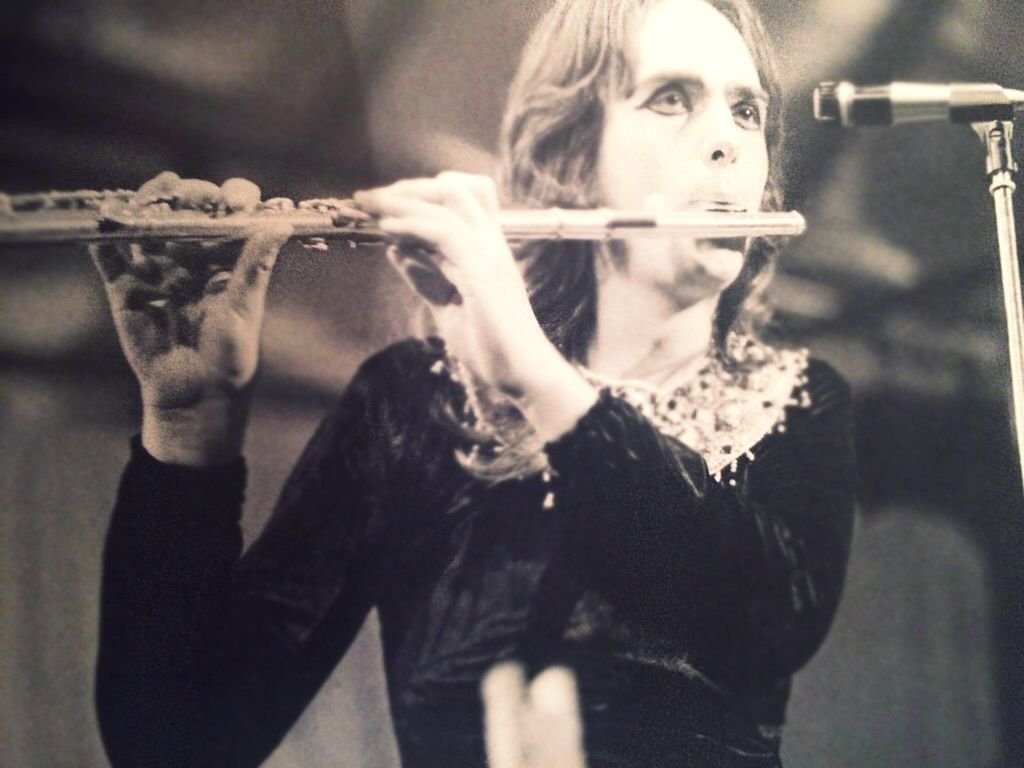Progressive rock, often affectionately known as prog rock, is a genre that prides itself on complexity, innovation, and the breaking of musical boundaries. Emerging in the late 1960s and early 1970s, this genre took the foundational elements of rock and infused them with a spirit of experimentation. Prog rock bands are known for their ambitious compositions, incorporating lengthy instrumental passages, complex time signatures, and a fusion of musical styles ranging from classical and jazz to folk and electronic. This eclectic approach not only broadened the sonic landscape but also redefined what rock music could encompass.
At the heart of this instrumental variety is the flute, an instrument more traditionally aligned with orchestral compositions than the rock genre. Its incorporation into prog rock marked a distinctive shift from mainstream rock’s reliance on guitars and drums, bringing a fresh, melodic contrast to the heavier sounds of bass and electric guitars. The flute’s ethereal tones and dynamic flexibility offered a new layer of auditory expression. It provided a delicate balance between the powerful and the sublime, allowing bands to explore a wider emotional range within their music.
The impact of the flute in progressive rock cannot be overstated. It has not only enriched the texture of the music but also helped to forge a unique identity for bands willing to step away from conventional rock formats. Through the innovative use of the flute, prog rock artists have been able to craft soundscapes that are as intricate as they are enchanting, captivating audiences and cementing the genre’s place in musical history. As we delve deeper into the evolution and significance of this remarkable instrument within prog rock, we uncover not just a story of musical adaptation, but a tale of artistic revolution.
Historical Context

Progressive rock emerged as a genre during a time of musical experimentation and cultural shifts in the late 1960s. As artists and bands began to seek ways to expand the expressiveness of rock music, they turned to more complex compositions and diverse musical influences. The genre’s roots can be traced to the desire to transcend the traditional structures and repetitiveness of mainstream rock.
Bands like Pink Floyd, King Crimson, and Yes ventured into uncharted territories by incorporating symphonic elements, jazz improvisations, and conceptual album structures into their work. This was not just about making longer songs but about crafting whole albums that were designed to be listened to as a single, cohesive piece, often telling a story or exploring a theme. This shift towards an album-centric approach marked a significant change from the singles-focused trends prevalent in the music industry.
Introduction of the Flute into Rock
The integration of the flute into rock music can be largely attributed to the burgeoning desire among rock musicians to explore and assimilate various musical textures and timbres. The flute entered the rock scene as part of this broader push towards a more eclectic sound palette. One of the early and most influential flautists in rock music was Ian Anderson of Jethro Tull. Anderson’s adoption of the flute was initially a pragmatic choice—he felt he could not compete with the electric guitar or saxophone, but found his niche with the flute, an instrument no other rock band prominently featured at the time.
Ian Anderson’s performance on the flute became one of the defining features of Jethro Tull’s sound, especially evident in albums like “Stand Up” (1969) and “Aqualung” (1971). His vigorous, sometimes gritty style of playing, which included singing and breathing into the flute to create rhythmic, percussive sounds, showcased the instrument’s versatility in a rock setting. Anderson’s influence was profound, encouraging other bands to experiment with the flute. Bands like Traffic, led by Steve Winwood, and Genesis, with Peter Gabriel, also began incorporating the flute into their arrangements, further solidifying its role within the progressive rock genre.
This period of musical experimentation highlighted the flute’s capacity to add a distinct voice to the rock ensemble, enriching the genre’s sound with its lyrical and melodic potentials. The instrument’s classical connotations and its ability to traverse from whispery tones to piercing high notes allowed prog rock musicians to evoke a broader spectrum of emotional nuances, making the flute a perfect tool for the genre’s complex narratives and expansive explorations.
The Flute’s Appeal

The flute’s contribution to progressive rock is profound, enhancing the genre with its distinctive sonic qualities that diverge significantly from the typical rock instrumentation. The instrument itself possesses a purity of tone and a capacity for both ethereal and piercing sounds, which can seamlessly weave through the dense layers of electric guitars, keyboards, and drums that characterize the genre. Its ability to produce a wide variety of sounds—from the soft, mellow tones that suggest a pastoral calm to the sharp, bright timbres that can cut through a heavy ensemble—adds a dynamic range to progressive rock compositions.
Moreover, the flute can mimic the human voice, with its ability to bend notes and express vibrato, adding a human touch to tracks without the use of words. This quality makes it especially valuable in the largely instrumental passages common in prog rock, where the music itself must carry the narrative or emotional weight. In this way, the flute serves not only as a melodic lead or a harmonic filler but also as a bridge between the orchestral and rock elements, facilitating a fusion that defines the genre’s eclectic nature.
Emotional Expressiveness
The emotional expressiveness of the flute in progressive rock cannot be understated. Its range and timbre allow it to convey a broad spectrum of feelings, from melancholy and longing to joy and exhilaration. This emotional versatility makes it an ideal instrument for the storytelling that is pivotal in progressive rock. The flute’s lower registers can evoke a sense of warmth and nostalgia, often utilized in slower, more introspective sections of a song. Conversely, its upper registers can impart a sense of urgency or intensity, useful in building climactic moments.
The flute’s expressiveness is further exemplified in how it interacts with other instruments in a band’s lineup. It can mirror the lilting rise and fall of a guitar solo, underscore the dramatic punches of percussion, or float above a dense orchestral arrangement, pulling listeners into a deeper emotional engagement with the music. This interaction not only highlights the flute’s adaptability but also its ability to enhance the emotional landscape of a piece, guiding the listener’s journey through the complex structures and motifs typical of progressive rock.
Key Flautists and Their Influence

One cannot discuss the flute in progressive rock without foregrounding Ian Anderson of Jethro Tull, whose innovative use of the flute is almost synonymous with the genre itself. Anderson transformed the flute from a classical and jazz staple into a vital rock instrument, redefining its possibilities. His aggressive, stand-up performance style and the incorporation of unusual techniques, such as singing, grunting, and breathing rhythmically into the flute, created a compelling stage presence and a distinctive musical voice within the rock genre.
Another seminal figure is Thijs van Leer of the Dutch band Focus. Van Leer, classically trained, brought a virtuosic flair to his performances, incorporating yodeling and organ playing alongside his intricate flute work. His ability to blend baroque and rock styles helped make albums like “Moving Waves” (1971) and their hit “Hocus Pocus” stand out for their creative ambition and technical prowess.
Peter Gabriel, during his time with Genesis, also contributed significantly to the flute’s role in progressive rock. Although better known for his vocal and theatrical performances, Gabriel’s flute playing added a hauntingly beautiful layer to Genesis’s complex compositions, particularly in the band’s early works.
Notable Performances
Ian Anderson’s flute is pivotal in Jethro Tull’s “Aqualung,” especially notable in the track “My God.” This song not only showcases Anderson’s skillful flute play but also his ability to integrate the flute seamlessly into a rock context, using it to build a powerful critique of organized religion. The flute’s solo introduction sets a meditative tone, which contrasts dramatically with the song’s heavier, guitar-driven segments, demonstrating the flute’s dynamic range and emotional capacity.
Thijs van Leer’s contributions shine brightly on Focus’s “Moving Waves.” The album’s instrumental, “Focus II,” features van Leer’s melodic flute lines weaving through complex keyboard harmonies and guitar riffs, highlighting his fluid, expressive style and the seamless integration of the flute into the band’s sound.
Peter Gabriel’s work on Genesis’s album “Nursery Cryme” features the flute prominently, especially in “The Musical Box.” Here, the flute adds a whimsical, yet eerie atmosphere to the track, enhancing the narrative’s fantastical and slightly macabre elements, and underlining Gabriel’s talent for using the flute to amplify storytelling in music.
These artists and their performances illustrate the diverse ways the flute has been employed in progressive rock, not just as a novelty but as a core element of the genre’s sound and emotional expression. Through their pioneering efforts, these flautists have secured the flute’s place in the annals of rock music, inspiring subsequent generations of musicians to explore and innovate further.
Technical Aspects

The integration of the flute into progressive rock not only expanded the genre’s sonic boundaries but also led to the development of unique playing techniques that blend classical styles with the bold textures of modern rock. Rock flautists like Ian Anderson introduced a variety of unconventional methods to enhance the flute’s presence in a band setting dominated by electric instruments.
One prominent technique is the use of percussive breathing and overblowing. These methods produce a grittier, more forceful sound from the flute, making it more comparable in energy to electric guitars and drums. Anderson often employed these techniques mid-performance to create rhythmic patterns or to accentuate certain beats, adding a robust layer to Jethro Tull’s music that was both surprising and engaging.
Extended techniques such as flutter tonguing, where the flautist rolls ‘r’s while playing, and double tonguing, a method that allows for faster articulation, are also used. These techniques, borrowed from classical music but given a new twist in rock, enable flautists to explore a wider range of textures and speeds, thus contributing to the complex musical tapestries characteristic of progressive rock.
Innovations
Adapting the flute to fit into the amplified and electronically enhanced world of rock music also led to several innovations, particularly in terms of instrument modification and the use of electronic effects. To compete with the volume of electric guitars and drums, some flautists started using microphones attached directly to their instruments. This not only amplified their sound but also allowed for the use of effects pedals to manipulate their tone, delay, reverb, and distortion in real-time during performances.
Ian Anderson, for example, experimented with various electronic enhancements, including the use of a wireless microphone system that freed him from the constraints of standing still at a microphone stand. This innovation was crucial for his dynamic performance style. Additionally, effects like the wah-wah pedal, which is more typically associated with electric guitars, were adapted for use with the flute, allowing flautists to modify their sound live and create a more engaging and contemporary musical expression.
The Flute in Modern Progressive Rock

The flute’s role in progressive rock continues to evolve, with modern bands and artists embracing and expanding its use in innovative ways. Bands like Big Big Train and The Mars Volta have incorporated the flute into their music, ensuring the instrument remains a significant element of the progressive rock landscape.
Big Big Train, a British band known for their lyrical storytelling and complex compositions, frequently employs the flute to evoke pastoral and quintessentially English imagery, much in the tradition of early progressive rock. Their use of the flute can be heard prominently in albums like “Folklore” and “Grimspound,” where it enhances the narrative and adds a layer of nostalgic elegance.
The Mars Volta, known for their experimental rock style, incorporates the flute in a more avant-garde and aggressive manner. Their use of the flute, especially in albums like “Frances the Mute,” demonstrates how it can be integrated into progressive rock with a more modern, eclectic approach. The flute passages in their music often serve as a counterpoint to the intense, often chaotic energy of their sound, providing moments of melodic relief.
Evolution of Style
The style and application of the flute in progressive rock have seen significant changes from its origins to the present day. Initially used more as a novelty or for specific atmospheric effects, the flute has become a more integral part of the progressive rock ensemble, often featured in lead melodic roles alongside or even in place of traditional rock instruments like guitars.
Technological advancements have also influenced how the flute is used in the genre. The integration of digital effects and looping technologies allows modern flautists to layer sounds, create complex textures, and interact with other electronic elements in a composition. This technological integration helps maintain the flute’s relevance in a genre that is continually pushing musical boundaries.
Moreover, the cultural exchange facilitated by globalization has introduced a variety of flute types and styles from different traditions into progressive rock. Bands are increasingly incorporating instruments like the bamboo flute, panpipes, and other ethnic woodwinds, enriching the genre’s sound palette and broadening its global appeal.
Cultural Impact

In the realm of progressive rock, the flute brings with it a rich tapestry of symbolism and imagery, often evoking a sense of the mystical, the pastoral, and the transcendent. Its delicate sound contrasts with the heavier elements typical of rock music, lending a spiritual or ethereal quality to the music. This juxtaposition can enhance the thematic content of a song or album, where the flute often underscores narratives of nature, folklore, and introspection.
The flute’s classical heritage also adds a layer of cultural prestige and historical depth, connecting modern compositions with traditional and classical musical forms. This connection imbues the music with a sense of continuity and sophistication, elevating the genre beyond the conventional rock soundscape. For instance, in Jethro Tull’s work, the flute’s medieval and baroque connotations complement the band’s complex lyrics and themes, which frequently draw on historical and literary references.
Fan Perception
Among fans of progressive rock, the flute is celebrated not only for its musical contribution but also for its role in defining the uniqueness of the genre. Enthusiasts often regard the instrument as a symbol of progressive rock’s willingness to diverge from mainstream rock norms, embracing complexity, and experimentation. This appreciation is deeply connected to the fans’ broader tastes for music that challenges and engages on multiple levels—intellectually, emotionally, and technically.
The distinctiveness of the flute’s sound also helps fans identify specific bands or songs, serving as a signature element that can instantly evoke a particular group’s style or a memorable musical moment. For example, the opening flute riff of “Bourée” by Jethro Tull is instantly recognizable to many fans and has become iconic within the genre. This recognition extends to live performances, where the visual spectacle of flute playing—often highlighted by dynamic and theatrical stage antics, as seen with Ian Anderson—deepens fan engagement and enjoyment.
Furthermore, the use of the flute often invites fans to explore a broader range of musical influences, including jazz, classical, and world music, expanding their musical horizons and deepening their appreciation for progressive rock’s diverse influences. This educational aspect of fan experience underscores the role of progressive rock not just as entertainment but as a formative cultural force.
Overall, the cultural impact of the flute in progressive rock is substantial, enriching the genre’s sound, broadening its thematic possibilities, and cultivating a devoted fanbase that values musical innovation and complexity. The flute’s continued presence in progressive rock speaks to its ability to adapt and resonate within an ever-evolving musical and cultural landscape.
